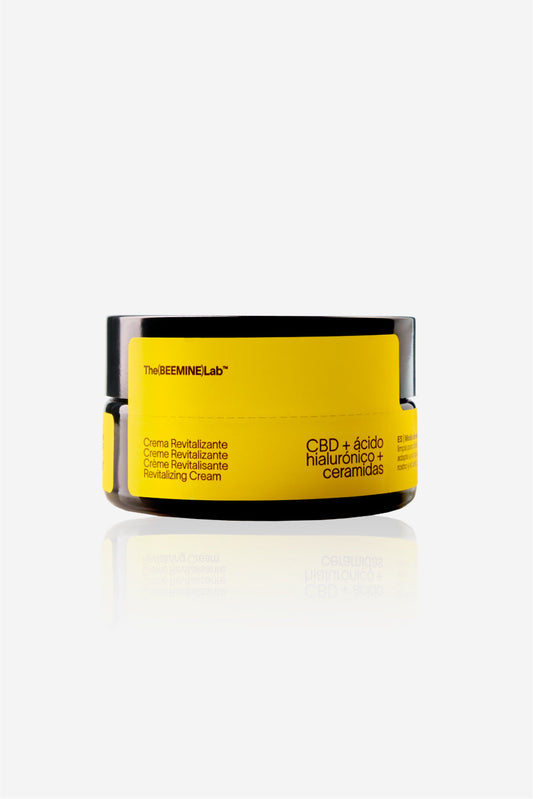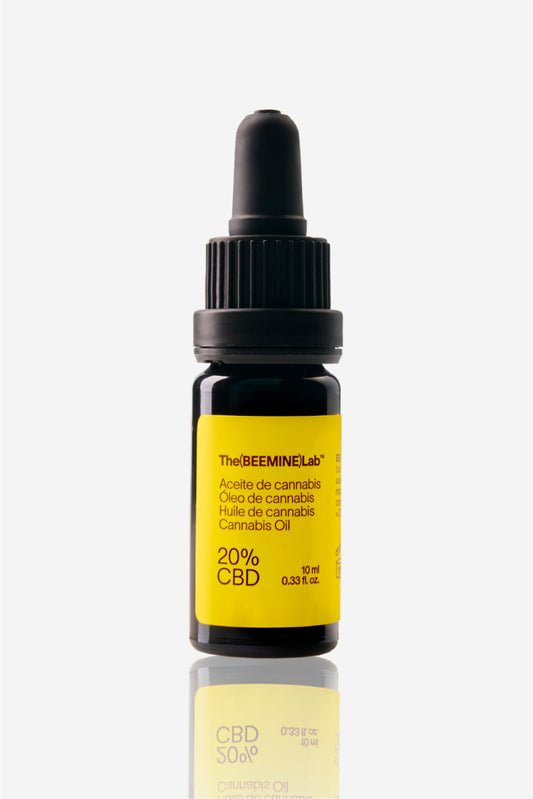What are the benefits of CBD for the skin?
Cannabinoids have demonstrated their anti-inflammatory, antipruritic, anti-aging and anti-tumor properties through several mechanisms, including the Endocannabinoid System. This discovery may provide an alternative to traditional treatments for skin conditions. In this article we focus on the therapeutic properties for the skin of one of the most studied Cannabinoids, Cannabidiol.Cannabidiol
Cannabidiol , known by its acronym CBD, is a substance present in the Cannabis plant. It belongs to the group of non-psychoactive phytocannabinoids (phyto = derived from plants) and the WHO recognizes its medicinal and therapeutic potential due to its multitude of anti-inflammatory, antioxidant, analgesic, antibacterial and anxiolytic properties .The skin: The epidermis, the dermis and the hypodermis
We will begin by defining what the skin is. The skin is an organ of our body, composed of a complex barrier of several layers, whose function is to protect us from external factors . It is the largest organ of our body, and can account for up to 1/7 of our weight . The skin consists of 3 layers: the epidermis, the dermis and the hypodermis. We will start by defining what skin is. Skin is an organ of our body composed of a complex multi-layered barrier responsible for protecting us from external factors. It is the largest organ of our body, it can be up to 1/7 of our entire weight. The skin consists of 3 layers: The epidermis, the dermis and the hypodermis.- The epidermis : This is the outermost part of our skin and is made up of four distinct layers of differentiated skin cells. The epidermis plays a key role as a barrier against infections, pollutants and UV damage , while also preventing dehydration caused by trans-epidermal water loss.
- The dermis : The dermis is located directly beneath the epidermis and plays a vital role in the health of the epidermis . It also acts as an environmental sensor.
- The hypodermis : The last layer of our skin, the hypodermis connects our skin to our body . It is mostly made up of fat, connective tissue and water. It could be defined as a pillow for our joints and bones . Another of its functions is to synthesize hormones and vitamins that are important for our body, such as Vitamin D. Controlled sun exposure of our arms and legs is the easiest way to provide our body with its daily dose of Vitamin D.
The Endocannabinoid System and the skin
Our Endocannabinoid System , also known by its acronym in English, ECS, is a system that was discovered just 30 years ago. Today we know its regulatory function for almost any physiological function you can imagine. We are talking about a complex inter-cellular communication system responsible for working on the regulation of different processes in our body, one of the organs where it is present is our skin. In recent years, the important role of the ECS in regulating the processes of our skin has been discovered. This is due to the discovery of ECS receptors in our skin. A 2019 study, “Cannabinoid Signaling in the Skin: Therapeutic Potential of the EndoCannabinoid System,” highlights the intrinsic role of the ECS in regulating and balancing our skin by noting that a variety of afflictions such as atopic dermatitis, psoriasis, acne, depigmentation, itching, and some tumors can originate due to imbalances in the ECS. The ECS helps regulate important functions of our skin, such as:- The production of cytokines, proteins of our immune system that can produce inflammatory and anti-inflammatory responses.
- The production of sebum, our natural fat.
- The production of cells, responsible for regenerating and repairing our skin.
The benefits of CBD for the skin
CBD offers a wide range of benefits without any serious side effects. It is worth highlighting its regulatory and not inhibitory action . Many of the substances used for the treatment of diseases and topical problems include harmful chemicals , steroids, corticosteroids or other ingredients responsible for inhibiting some of the symptoms , but they are not responsible for controlling the root problem. By inhibiting natural processes in our body we cannot achieve a stable balance in our skin. CBD interacts with our skin by activating the Endocannabinoid System to help regulate its processes, offering its anti-inflammatory, antioxidant, and analgesic properties, as well as its fatty acids and other nutrients necessary for our skin. It is one of the most studied cannabinoids with promising results for the treatment of topical afflictions such as atopic dermatitis, acne, pruritus, and psoriasis.Benefits of CBD for different skin types
Now that we have a better understanding of how our skin, the Endocannabinoid System and CBD work, let's distinguish how CBD can help different skin types.For atopic skin and/or skin with atopic dermatitis or psoriasis
The anti-inflammatory and pain-relieving properties of CBD can help soothe and reduce itching for people suffering from atopic dermatitis. Cannabidiol has been studied for a variety of topical afflictions including atopic dermatitis (eczema), psoriasis, and pruritus (itching). These topical afflictions are autoimmune diseases , meaning the immune system itself becomes the damaging factor and harms healthy tissues and/or organs. One of the substances most commonly used to treat this type of affliction is corticosteroids . Corticosteroids are immunosuppressive substances whose job is to shut down autoimmune processes , processes that are beneficial and necessary to fight infections as long as they are not attacking our own system. This is why corticosteroid treatments can make people more susceptible to infections and are only suitable for certain cases. On the other hand, Cannabidiol offers us a natural option that helps regulate but does not seem to oppress our immune system , allowing our body to reach a balance where it will not attack our healthy tissues and is able to respond to infections. Numerous studies have shown the ability of CBD to activate anandamide . This endocannabinoid has a series of antipruritic and analgesic properties that inhibit TRPV activity in pain-sensitive neurons, called nociceptors, and itch-sensitive neurons, called nociceptors. Overactive or hypersensitive TRPV1 activity can lead to excessive transmission of pain and itch sensations, so reducing TPRV1 activity may offer a promising treatment for people with atopic dermatitis or pruritus.For oily and/or acne-prone skin
Acne is one of the most common skin conditions , affecting 80% of people at some point in their lives. Treatments focus on reducing the amount of sebum, bacteria and inflammation in the skin. We were talking earlier about the functions of the endocannabinoid system in our skin, one of the functions is the regulation of sebum production (our natural oil). Adequate levels of sebum production are protective, help in the elasticity of our skin , protect against external factors and much more; however, people with oily or acne-prone skin overproduce these natural oils which can clog pores and allow bacteria to grow. CBD regulates the production of lipids (such as sebum) as well as containing antibacterial properties, making it a perfect substance to help cleanse, balance the oil production of our skin and prevent the appearance of infections and blackheads. Its anti-inflammatory effects also help reduce the redness, swelling and pain associated with acne breakouts and relieve uncomfortable and painful symptoms. In preclinical studies , CBD is shown to be a potential cannabinoid for the treatment of acne vulgaris . CBD suppressed sebocyte proliferation by activating the TRPV4 receptor, influencing the regulation of glucose and lipid metabolism.For sensitive skin
CBD can be a great ally for people with sensitive skin. It regulates sebum production, reduces redness, soothes and moisturizes, and provides a natural glow to the skin. Its great potential to regulate skin processes offers a natural remedy that soothes and calms the dermis. Its anti-inflammatory properties help reduce redness in skin prone to irritation and itching.For mature skin
Not only does CBD contain high levels of antioxidants , it can also signal our skin to activate its natural antioxidants . These help the skin regain its natural glow. These antioxidant pathways work together to prevent damage, they can also slow down the skin’s aging process and smooth out wrinkles by fighting free radicals and pollution. The endocannabinoid system plays an important role in regulating skin cell regeneration, also known as cell turnover. By enhancing our endocannabinoid system with CBD, we can ensure quality cell turnover , replacing dead skin cells with new ones and preventing excessive buildup that can make our skin look dull, helping our skin regain its natural glow.The benefits of other cannabinoids for the skin
Right now, most cannabinoid studies focus on CBD and THC due to their greater presence in the Cannabis Sativa L. plant . However, there are more than 113 cannabinoids with different promising effects . More research is needed, but every day we get closer to knowing more about this plant and its beneficial uses for the skin. Below we will mention the therapeutic potential of other cannabinoids to treat skin ailments.- CBG: Cannabigerol is a non-psychoactive cannabinoid with potential to treat dry skin and inflammation due to its moisturizing, analgesic and antibacterial properties.
- THC: Known for its psychoactive effects, THC has significant analgesic and anti-inflammatory properties. It has been studied topically to help relieve the itching of atopic dermatitis. However, there are studies that indicate that THC is not absorbed as efficiently into the skin as CBD .
- CBN: Cannabinol has very interesting anti-inflammatory and antibacterial properties for topical use.
- CBC : Cannabichromene has been studied for its anti-inflammatory and sebum production regulating effects. As studies progress, we will know if this cannabinoid can be an ally in treating acne.
- Oláh A, Tóth BI, Borbíró I, et al. “Cannabidiol exerts sebostatic and antiinflammatory effects on human sebocytes . ” J Clin Invest . 2014;124(9):3713?3724. doi:10.1172/JCI64628
- Mounessa, Jessica S. et al. “The role of cannabinoids in dermatology” Journal of the American Academy of Dermatology, Volume 77, Issue 1, 188 - 190
- Eagleston, Lauren et al. “ Cannabinoids in dermatology: A scoping review” UC Davis Dermatology Online Journal, 24(6). 2018
- Casares L, García V, Garrido-Rodríguez M, et al. “ Cannabidiol induces antioxidant pathways in keratinocytes by targeting BACH1 .” Redox Biol . 2020;28:101321. doi:10.1016/j.redox.2019.101321
- Tóth KF, Ádám D, Bíró T, Oláh A. “ Cannabinoid Signaling in the Skin: Therapeutic Potential of the "C(ut)annabinoid" System ”. Molecules . 2019;24(5):918. Published 2019 Mar 6. doi:10.3390/molecules24050918
- Misuraca, Melinda. “Can CBD help your complexion?” Project CBD. 2019
- Sheriff, Tabrez & Lin, Matthew & Dubin, Danielle & Khorasani, Hooman. (2019). The potential role of cannabinoids in dermatology. Journal of Dermatological Treatment . 1-7. 10.1080/09546634.2019.1675854.
- Stinchcomb AL, Valiveti S, Hammell DC, Ramsey DR. Human skin permeation of Delta8-tetrahydrocannabinol, cannabidiol and cannabinol . J Pharm Pharmacol . 2004;56(3):291?297. doi:10.1211/0022357022791
- Russo, S. Molecular Mimicry: The Role of Cannabis in Healing Autoimmune Disease . Canna Foundation.







